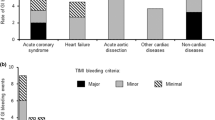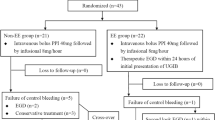Abstract
Background
Potent antiplatelet and anticoagulant agents along with early revascularization are increasingly used in patients hospitalized with acute coronary syndromes (ACS). An important complication associated with these therapies is gastrointestinal bleeding (GIB); yet, the predictors, optimal management, and outcomes associated with GIB in ACS patients are poorly studied.
Methods
We investigated the incidence, predictors, pathological findings, and clinical outcomes associated with GIB in patients with ACS hospitalized at a United States tertiary center between 1996 and 2001.
Results
Three percent (80/3,045) of ACS patients developed clinically significant GIB. Predictors of GIB were older age, female gender, non-smoking status, peak troponin I, and prior heart failure, diabetes, or hypertension. Patients with GIB were more critically ill with lower blood pressure and higher heart rates. GIB was associated with an increased need for transfusion, mechanical ventilation, and inotropes/pressors. In-hospital mortality was significantly higher in ACS patients with versus without GIB (36% vs. 5%, P < 0.001). Thirty patients (38%) with GIB underwent endoscopy with no procedural complications of death, arrhythmia, urgent ischemia, or hemodynamic deterioration.
Conclusion
In patients with ACS, GIB is associated with older age, female sex, peak troponin I, non-smoking status, diabetes, hypertension, and heart failure. Hospital mortality is increased eightfold when ACS patients experience GIB. More studies are needed to establish the safety of and optimal timing of endoscopy in these patients.
Similar content being viewed by others
References
The GUSTO Investigators (1993) An international randomized trial comparing four thrombolytic strategies for acute myocardial infarction. N Engl J Med 329:673–682
Clason AE, Macleod DAD, Elton RA (1986) Clinical factors in the prediction of further haemorrhage or mortality in acute upper gastrointestinal haemorrhage. Br J Surg 73:985–987
Larson G, Schmidt T, Gott J et al (1986) Upper gastrointestinal bleeding: predictors of outcome. Surgery 100:756–773
Provenzale D, Sandler RS, Wood DR et al (1987) Development of a scoring system to predict mortality from upper gastrointestinal bleeding. Am J Med Sci 294:26–32
Lewis JD, Shin EJ, Metz DC (2000) Characterization of gastrointestinal bleeding in severely ill hospitalized patients. Critical Care Med 28:46–50
Cappell MS (2000) Gastrointestinal bleeding associated with myocardial infarction. Gastroenterol Clin North Am 29:423–444
Cappell MS, Iacovone FM Jr (1999) Safety and efficacy of esophagogastroduodenoscopy after myocardial infarction. Am J Med 106:29–35
Cappell MS, Iacovone FM Jr (1996) The safety and efficacy of percutaneous endoscopic gastrostomy after recent myocardial infarction: a study of 28 patients and 40 controls at four university teaching hospitals. Am J Gastroenterol 91:1599–1603
Cappell MS, Huh C (1995) A study of the safety and clinical efficacy of esophagogastroduodenoscopy after esophageal, gastric, or duodenal surgery in 60 patients. Am J Gastroenterol 90:1268–1272
Rasty S, Borzak S, Tisdale JE (2002) Bleeding associated with eptifibatide targeting higher risk patients with acute coronary syndromes: incidence and multivariate risk factors. J Clin Pharmacol 42:1366–1373
Cappell MS (1995) A study of the syndrome of simultaneous acute upper gastrointestinal bleeding and myocardial infarction in 36 patients. Am J Gastroenterol 90:1444–1449
Emenike E, Srivastava S, Amoateng-Adjepong Y et al (1999) Myocardial infarction complicating gastrointestinal hemorrhage. Mayo Clin Proc 74:235–241
Bhatti N, Amoateng-Adjepong Y, Qamar A, Manthous CA (1998) Myocardial infarction in critically ill patients presenting with gastrointestinal hemorrhage: retrospective analysis of risks and outcomes. Chest 114:1137–1142
Lee JG, Krucoff MW, Brazer SR (1995) Periprocedural myocardial ischemia in patients with severe symptomatic coronary artery disease undergoing endoscopy: prevalence and risk factors. Am J Med 99:270–275
Author information
Authors and Affiliations
Corresponding author
Rights and permissions
About this article
Cite this article
Al-Mallah, M., Bazari, R.N., Jankowski, M. et al. Predictors and outcomes associated with gastrointestinal bleeding in patients with acute coronary syndromes. J Thromb Thrombolysis 23, 51–55 (2007). https://doi.org/10.1007/s11239-006-9005-8
Published:
Issue Date:
DOI: https://doi.org/10.1007/s11239-006-9005-8




